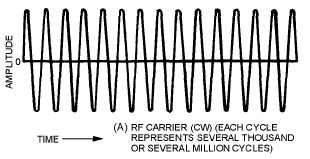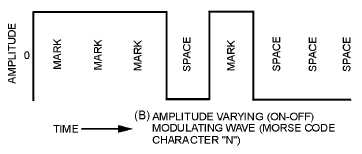2-2
ANGLE MODULATION
ANGLE MODULATION is modulation in which the angle of a sine-wave carrier is varied by a
modulating wave. FREQUENCY MODULATION (fm) and PHASE MODULATION (pm) are two types
of angle modulation. In frequency modulation the modulating signal causes the carrier frequency to vary.
These variations are controlled by both the frequency and the amplitude of the modulating wave. In phase
modulation the phase of the carrier is controlled by the modulating waveform. Let’s study these
modulation methods for an understanding of their similarities and differences.
FREQUENCY-MODULATION SYSTEMS
In frequency modulation an audio signal is used to shift the frequency of an oscillator at an audio
rate. The simplest form of this is seen in FREQUENCY-SHIFT KEYING (fsk). Frequency-shift keying is
somewhat similar to continuous-wave keying (cw) in AM transmissions.
Frequency-Shift Keying
Consider figure 2-1, views (A) through (D). View (A) is a radio frequency (rf) carrier which is
actually several thousand or million hertz. View (B) represents the intelligence to be transmitted as
MARKS and SPACES. Recall that in cw transmission, this intelligence was applied to the rf carrier by
interrupting the signal, as shown in view (C). The amplitude of the rf alternated between maximum and 0
volts. By comparing views (B) and (C), you can see the mark/space intelligence of the Morse code
character on the rf. The spacing of the waveform in view (D) is an example of the same intelligence as it
is applied to the frequency instead of the amplitude of the rf. This is simple frequency-shift keying of the
same Morse code character.
Figure 2-1A.—Comparison of ON-OFF and frequency-shift keying. RF CARRIER (CW) (EACH CYCLE
REPRESENTS SEVERAL THOUSAND OR SEVERAL MILLION CYCLES).
Figure 2-1B.—Comparison of ON-OFF and frequency-shift keying. AMPLITUDE VARYING (ON-OFF)
MODULATING WAVE (MORSE CODE CHARACTER "N").



